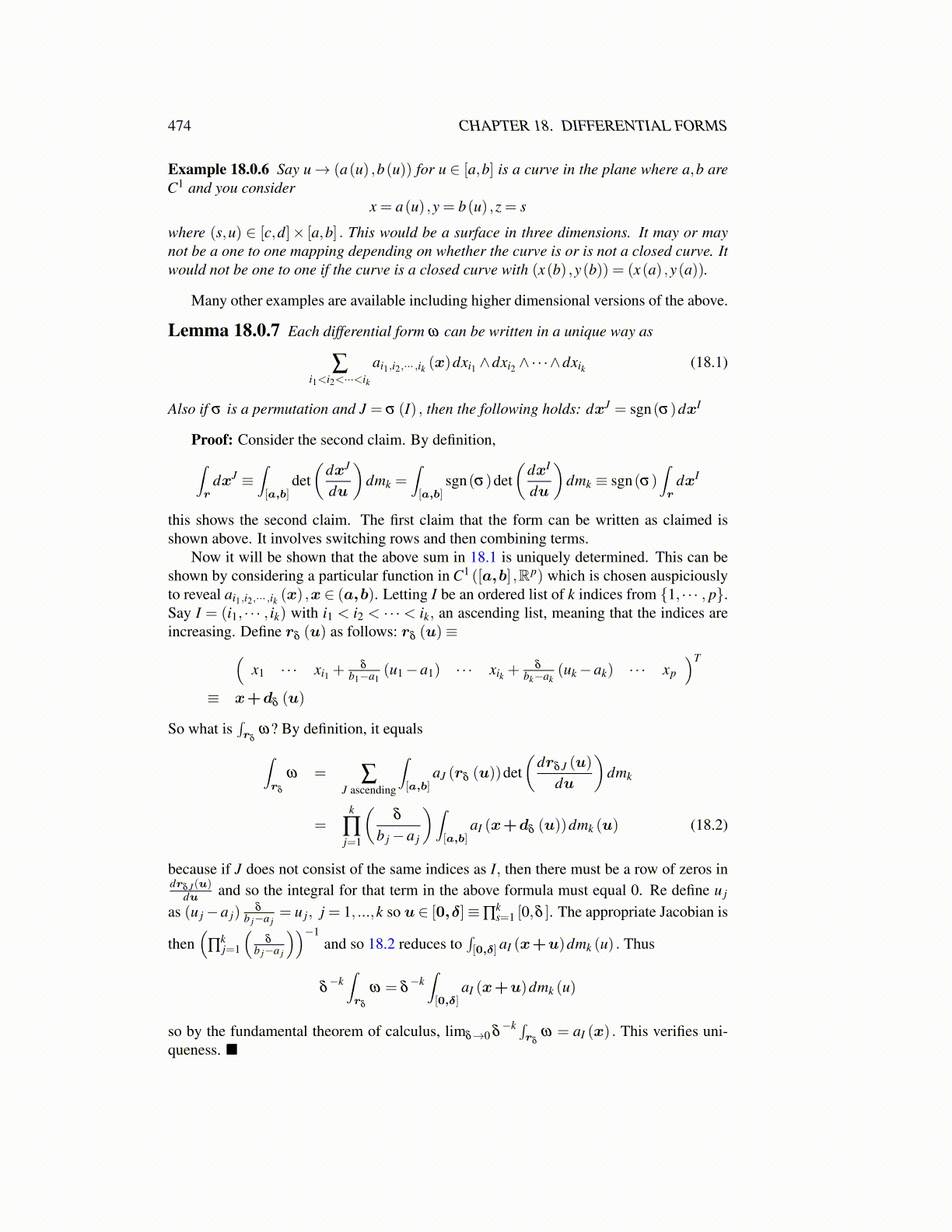
474 CHAPTER 18. DIFFERENTIAL FORMS
Example 18.0.6 Say u→ (a(u) ,b(u)) for u ∈ [a,b] is a curve in the plane where a,b areC1 and you consider
x = a(u) ,y = b(u) ,z = s
where (s,u) ∈ [c,d]× [a,b] . This would be a surface in three dimensions. It may or maynot be a one to one mapping depending on whether the curve is or is not a closed curve. Itwould not be one to one if the curve is a closed curve with (x(b) ,y(b)) = (x(a) ,y(a)).
Many other examples are available including higher dimensional versions of the above.
Lemma 18.0.7 Each differential form ω can be written in a unique way as
∑i1<i2<···<ik
ai1,i2,··· ,ik (x)dxi1 ∧dxi2 ∧·· ·∧dxik (18.1)
Also if σ is a permutation and J = σ (I) , then the following holds: dxJ = sgn(σ)dxI
Proof: Consider the second claim. By definition,∫r
dxJ ≡∫[a,b]
det(
dxJ
du
)dmk =
∫[a,b]
sgn(σ)det(
dxI
du
)dmk ≡ sgn(σ)
∫r
dxI
this shows the second claim. The first claim that the form can be written as claimed isshown above. It involves switching rows and then combining terms.
Now it will be shown that the above sum in 18.1 is uniquely determined. This can beshown by considering a particular function in C1 ([a,b] ,Rp) which is chosen auspiciouslyto reveal ai1,i2,··· ,ik (x) ,x ∈ (a,b). Letting I be an ordered list of k indices from {1, · · · , p}.Say I = (i1, · · · , ik) with i1 < i2 < · · · < ik, an ascending list, meaning that the indices areincreasing. Define rδ (u) as follows: rδ (u)≡(
x1 · · · xi1 +δ
b1−a1(u1−a1) · · · xik +
δ
bk−ak(uk−ak) · · · xp
)T
≡ x+dδ (u)
So what is∫rδ
ω? By definition, it equals∫rδ
ω = ∑J ascending
∫[a,b]
aJ (rδ (u))det(
drδJ (u)
du
)dmk
=k
∏j=1
(δ
b j−a j
)∫[a,b]
aI (x+dδ (u))dmk (u) (18.2)
because if J does not consist of the same indices as I, then there must be a row of zeros indrδJ(u)
du and so the integral for that term in the above formula must equal 0. Re define u j
as (u j−a j)δ
b j−a j= u j, j = 1, ...,k so u ∈ [0,δ]≡∏
ks=1 [0,δ ]. The appropriate Jacobian is
then(
∏kj=1
(δ
b j−a j
))−1and so 18.2 reduces to
∫[0,δ] aI (x+u)dmk (u) . Thus
δ−k∫rδ
ω = δ−k∫[0,δ]
aI (x+u)dmk (u)
so by the fundamental theorem of calculus, limδ→0 δ−k ∫
rδω = aI (x) . This verifies uni-
queness. ■